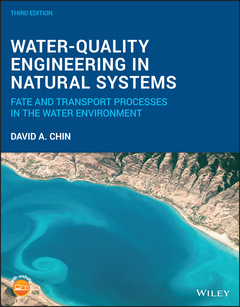Description
Water-Quality Engineering in Natural Systems (3rd Ed.)
Fate and Transport Processes in the Water Environment
Author: Chin David A.
Language: English
Subject for Water-Quality Engineering in Natural Systems:
656 p. · 22.1x27.4 cm · Hardback
Description
/li>Contents
/li>Biography
/li>
This textbook describes in detail the fundamental equations that govern the fate and transport of contaminants in the environment, and covers the application of these equations to engineering design and environmental impact analysis relating to contaminant discharges into rivers, lakes, wetlands, groundwater, and oceans. The third edition provides numerous end-of-chapter problems and an expanded solutions manual. Also introduced in this edition are PowerPoints slides for all chapters so that instructors have a ready-made course.
Key distinguishing features of this book include: detailed coverage of the science behind water-quality regulations, state-of-the-art methods for calculating total maximum daily loads (TMDLs) for the remediation of impaired waters, modeling and control of nutrient levels in lakes and reservoirs, design of constructed treatment wetlands, design of groundwater remediation systems, design of ocean outfalls, control of oil spills in the ocean, and the design of systems to control the quality of surface runoff from watersheds into their receiving waters. In addition, the entire book is updated to provide the latest advances in the field of water-quality control. For example, concepts such as mixing zones are expanded to include physical nature and regulatory importance of mixing zones, practical aspects of outfall and diffuser design are also included, specific details of water-quality modeling are updated to reflect the latest developments on this topic, and new findings relating to priority and emerging pollutants are added.
PREFACE xiii
1 INTRODUCTION 1
1.1 Background 1
1.2 Sources of Water Pollution 2
1.3 Control of Water Pollution 6
2 WATER QUALITY 9
2.1 Introduction 9
2.2 Physical Measures 9
2.3 Chemical Measures 14
2.4 Biological Measures 26
3 FUNDAMENTALS OF FATE AND TRANSPORT 37
3.1 Introduction 37
3.2 The Advection-Diffusion Equation 37
3.3 Fundamental Solutions of the Advection-Diffusion Equation 46
3.4 Advection and Diffusion of Heat 83
3.5 Transport of Suspended Particles 85
3.6 Fate and Transport of Microorganisms in Natural Waters 87
3.7 Turbulent Diffusion 88
3.8 Dispersion 95
4 RIVERS AND STREAMS 109
4.1 Introduction 109
4.2 Transport Processes 111
4.3 Models of Spills 125
4.4 Models of Dissolved Oxygen 134
4.5 Models of Nutrients 162
4.6 Models of Pathogens 163
4.7 Contaminant Loads 165
4.8 Management and Restoration 180
5 GROUNDWATER 195
5.1 Introduction 195
5.2 Contaminant Sources 195
5.3 Fate and Transport Models 202
5.4 Transport Processes 211
5.5 Fate Processes 221
5.6 Nonaqueous Phase Liquids 233
5.7 Monitoring Wells 241
5.8 Remediation of Subsurface Contamination 246
6 WATERSHEDS 275
6.1 Introduction 275
6.2 Urban Watersheds 276
6.3 Agricultural Watersheds 300
6.4 Airsheds 321
7 LAKES AND RESERVOIRS 325
7.1 Introduction 325
7.2 Physical Processes 329
7.3 Eutrophication 334
7.4 Thermal Stratification 343
7.5 Water-Quality Models 350
7.6 Management and Restoration 368
8 WETLANDS 381
8.1 Introduction 381
8.2 Natural Wetlands 381
8.3 Constructed Treatment Wetlands 389
9 OCEANS AND ESTUARIES 409
9.1 Introduction 409
9.2 Ocean Outfalls 410
9.3 Multiport Diffusers for Dense Discharges 436
9.4 Oil Spills 439
9.5 Chemical Spills 470
9.6 Estuaries 472
10 ANALYSIS OF WATER-QUALITY MEASUREMENTS 489
10.1 Introduction 489
10.2 Probability Distributions 489
10.3 Fundamental Probability Distributions 491
10.4 Derived Probability Distributions 497
10.5 Estimation of a Population Distribution from Sample Data 501
10.6 Estimation of Parameters of Population Distribution 507
10.7 Probability Distributions of Sample Statistics 511
10.8 Confidence Intervals 515
10.9 Hypothesis Testing 518
10.10 Relationships Between Variables 532
10.11 Functions of Random Variables 538
10.12 Kriging 543
11 MODELING 561
11.1 Introduction 561
11.2 Code Selection 562
11.3 Calibration 562
11.4 Validation 575
11.5 Simulation 575
11.6 Uncertainty Analysis 575
A UNITS AND CONVERSION FACTORS 581
A.1 Units 581
A.2 Conversion Factors 582
B FLUID PROPERTIES 585
B.1 Water 585
B.2 Organic Compounds Found in Water 587
B.3 Air at Standard Atmospheric Pressure 587
C STATISTICAL TABLES 589
C.1 Areas Under Standard Normal Curve 589
C.2 Critical Values of the t Distribution 591
C.3 Critical Values of the Chi-Square Distribution 592
C.4 Critical Values of the F Distribution (Alpha = 0.05) 593
C.5 Critical Values for the Kolmogorov-Smirnov Test Statistic 595
D SPECIAL FUNCTIONS 597
D.1 Error Function 597
D.2 Bessel Functions 598
D.3 Gamma Function 602
D.4 Exponential Integral 602
BIBLIOGRAPHY 605
INDEX 625
David A. Chin is a professor in the Department of Civil, Architectural, and Environmental Engineering at the University of Miami. He is a licensed Professional Engineer, a Board Certified Environmental Engineer, and a Fellow of the American Society of Civil Engineers. He has authored widely used textbooks on water-resources engineering and fluid mechanics, he has published extensively in peer reviewed journals, in addition to authoring the Wiley book on Water-Quality Engineering in Natural Systems.

